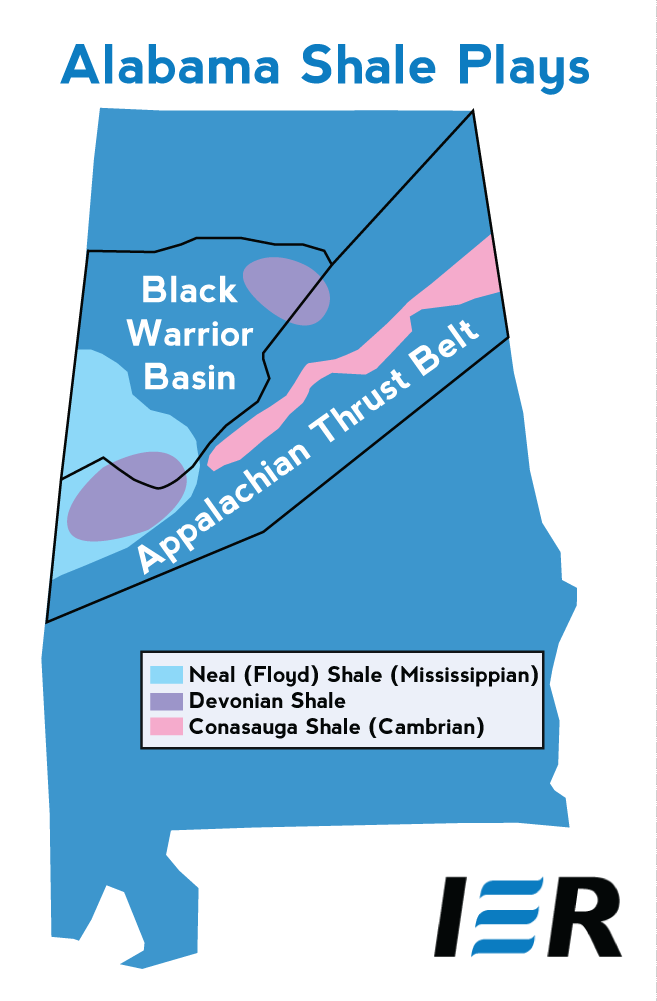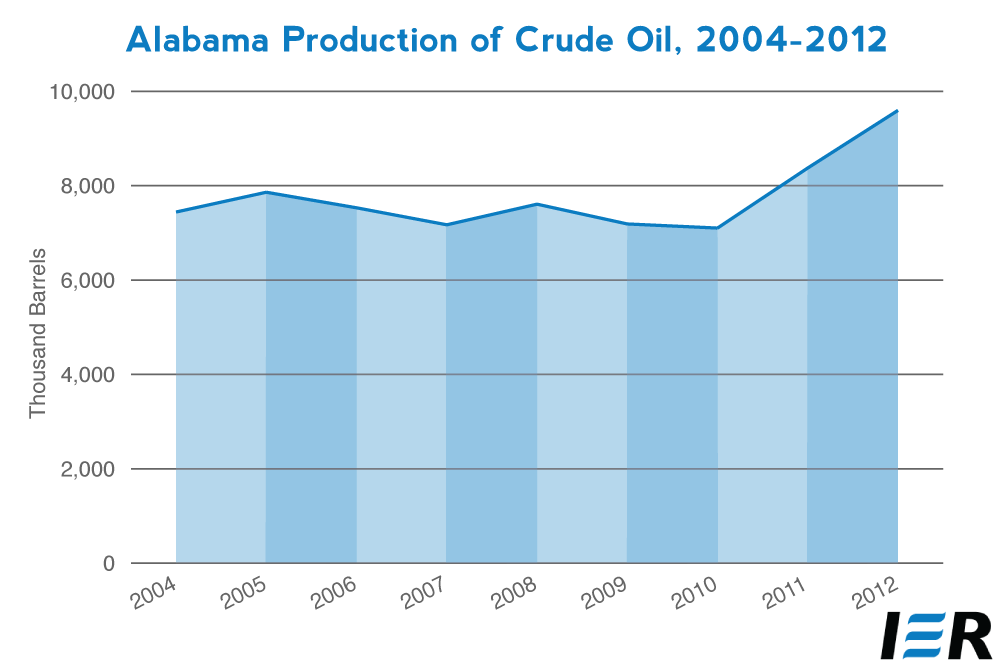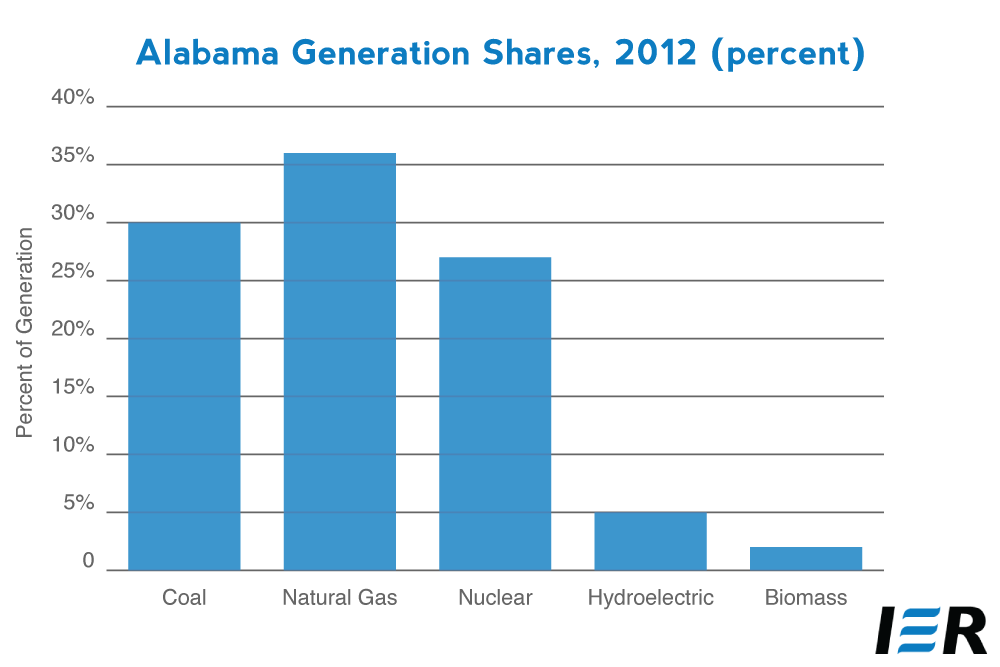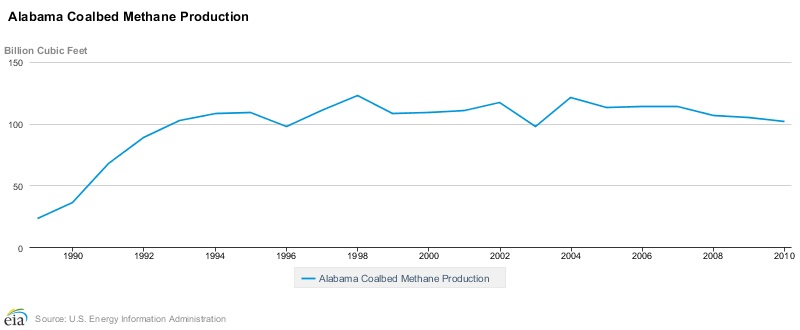Alabama has lower energy prices than the national average. Its gasoline price is the 12th lowest among the states and 5 percent below the national average. The state’s lower gasoline prices are due in large measure to the state’s numerous oil refineries and its proximity to the major oil producing and refining operations in the Gulf of Mexico. Its electricity prices are over 7 percent lower than the nation’s average electricity price due to its generation from coal, natural gas, and nuclear power sources. The state has considerable conventional and unconventional natural gas reserves, substantial deposits of coal, and numerous rivers capable of hydroelectric generation. Its oil production increased over 35 percent in just the last 2 years.
[table id=2 /]
Sources: Bureau of Economic Analysis (2011), Bureau of Labor Statistics, (January 2013), AAA Fuel Gauge Report (March 21, 2013), Energy Information Administration (February 2013)
Alabama’s State Rankings
- In 2010, Alabama ranked 13th among the states in total energy production, producing 1,420 trillion Btu of energy.
- In December 2012, it ranked 14th in crude oil production, producing 901 thousand barrels.
- In 2011, it ranked 14th in natural gas production, producing 195,581 million cubic feet of natural gas.
- In 2011, it ranked 15th in coal production, producing 19,071 thousand short tons of coal.
- In December 2012, it ranked 6th in electricity production, producing 12,654 thousand megawatt hours of electricity.
- In 2010, it ranked 12th in the total energy consumed per capita, consuming 410 million Btu per person.
Alabama’s annual natural gas production accounts for almost 1 percent of total U.S. output. More than one-half of this production typically comes from onshore wells. Alabama also gets gas from coalbed methane deposits (unconventional natural gas found trapped within coal seams) in the Black Warrior Basin and the Cahaba Coal Field.
Natural Gas
The Conasauga shale play in northern Alabama could provide a new source of natural gas production. The Conasauga runs in a 20 mile strip for 100 miles through Tennessee, Alabama, and Georgia. It is estimated to contain 625 trillion cubic feet of natural gas in Alabama
 Source: Geological Survey of Alabama
Source: Geological Survey of Alabama
Alabama’s natural gas production currently does not satisfy its state’s demand, which comes mostly from industrial users and electric power generators. Consequently, Alabama purchases additional supplies of natural gas that is transported by pipeline from the Gulf of Mexico, Louisiana, and Texas. The Southeast Supply Header pipeline with a capacity of 1 billion cubic feet per day transports natural gas from the Perryville Hub in Texas to southern Alabama. The pipeline gives Alabama consumers an alternative to offshore supply, which may be vulnerable to weather-related disruptions. In 2011, Alabama reached an historic number of wells producing natural gas, ranking 15th among the states.
Petroleum
Alabama produces crude oil from reserves located in the Black Warrior Basin in the north and the Gulf Coast in the south. Although Alabama’s oil production had been in decline since the early 1990s, new onshore drilling activity has occurred in recent years. To increase production from aging fields, producers have repaired old wells and applied new technology. Alabama produced 9,595 thousand barrels in 2012, 35 percent higher than in 2010, giving it a rank of 15 among the states in oil production.
Alabama has 3 petroleum refineries. One petroleum refinery is located near the Port of Mobile, a second is located in Tuscaloosa on the Black Warrior River, and a third is located in Atmore in the southern part of the State. Petroleum products made at Alabama’s refineries are delivered to local and regional markets and shipped via pipeline to states in the Northeast. Alabama markets receive additional finished petroleum products from Texas and Louisiana through the Colonial and Plantation pipelines.
 Source: Energy Information Administration
Source: Energy Information Administration
Coal, Electricity, and Renewable Energy
Alabama ranks among the top 10 states in electricity generation. Coal and natural gas are the dominant fuels for electric power generation, accounting for about two-thirds of the electricity produced within the State.
Alabama produces large amounts of coal in the northern part of the state. Additional coal, largely used for electricity generation, is shipped in from other states, primarily Wyoming, Kentucky, and West Virginia. In 2011, Mobile was the fourth largest seaport for exporting coal in the United States with coking coal used in the steelmaking process accounting for more than 90 percent of the total exports.
Alabama is a major nuclear power generator; its two nuclear power plants produce over one-fourth of the electricity generated in the State. The three reactors at the Browns Ferry nuclear power plant in Limestone County have a combined generating capacity of 3,310 megawatts, second only to Arizona’s Palo Verde plant. The state’s nuclear power capacity expanded in mid-2007 when the Tennessee Valley Authority (TVA) restarted a nuclear reactor at its Browns Ferry plant that had been idle since 1985.
In 2010, Alabama ranked sixth among the states in electricity generation from renewable energy resources with the majority generated by hydroelectric power. With more than two dozen hydroelectric dams located mainly along the Alabama and Coosa Rivers, Alabama is one of the top producers of hydroelectric power east of the Rocky Mountains. Hydroelectric power typically supplies at least 5 percent of the state’s electricity generation.
Alabama ranks among the top states in the generation of electricity from wood, wood waste, landfill gas, and other biomass, ranking fifth in the United States in 2011. Virtually all of that electricity was generated by nonutility power producers. The State also contains one of the world’s largest solid biofuel plants, designed to produce 520,000 metric tons of wood pellets each year, the majority of which is shipped to Europe. Several regions of Alabama are well suited for growing switchgrass, making the state a potential site for the installation of bioenergy plants.
Due to high demand from the industrial and residential sectors, Alabama’s total electricity consumption is relatively high compared to other states. Alabama’s per capita consumption of residential electricity is one of the highest in the country due to its air-conditioning demand during the hot summer months and its use of electricity for home heating during the generally mild winter months. However, despite high total and per capita electricity demand, Alabama electricity production exceeds consumption and the state exports large amounts of electricity to neighboring states via several high-voltage interstate transmission lines.
 Source: Energy Information Administration
Source: Energy Information Administration
Alabama State Regulatory Environment
Fortunately for the citizens of Alabama, the state has not imposed many of the regulations that other states have imposed that usually increase the price of energy. Alabama requires new state government buildings to meet buildings code and all new or replacement equipment purchased by state agencies to be Energy Star certified, when cost effective. The state does not, however, mandate the use of renewable energy in electric generation or blended into gasoline, as many states do.
In May 2006, the governor of Alabama issued Executive Order 33 mandating that state departments and agencies encourage and promote the conservation of energy in state-owned buildings. In November 2011, Executive Order 25 extended the energy standards for state agencies from Fiscal Year 2010 to Fiscal Year 2015. The initiative is to reduce energy consumption by 10 percent in all state-owned facilities by the end of Fiscal Year 2008, 20 percent by Fiscal Year 2010, and 30 percent by Fiscal Year 2015 from 2005 levels.
State departments and agencies are also encouraged to employ the latest energy-conservation practices in the design, construction, renovation, operation and maintenance of state facilities. All state agencies must implement the U.S. Environmental Protection Agency’s Energy Star Portfolio Manager data base tool to measure and report energy efficiency and compile quarterly reports required from the Alabama Department of Economic and Community Affairs (ADECA) Energy Division to the U.S. Department of Energy.
In December 2008, the Building Commission adopted the 2006 International Energy Conservation Code as the standard for new public buildings. When replacing or purchasing new equipment, state agencies must purchase Energy Star equipment when cost effective. In December 2008, the Building Commission adopted the 2006 International Energy Conservation Code as the standard for new public buildings and in September 2010, it adopted the 2009 International Building Code.
Other State Energy Programs
The state’s Renewable Energy Program promotes the adoption of renewable energy technologies to raise consumer awareness and acceptance of available biofuel, biomass, solar and biogas technologies through the demonstration of renewable energy technologies and active outreach.
The state’s Biomass Energy Program promotes wood waste as an alternative biomass energy source. Wood-industry participants have reduced production costs by using waste in the form of wood chips, sawdust and bark in new and/or converted wood-fired combustion systems. The program assists wood-industry and non-wood industry businesses with installing biomass energy systems, providing up to $75,000 in interest subsidy payments on loans to install approved biomass projects. Eligible applicants include industrial, commercial, and institutional facilities, as well as agricultural property owners and city, county, and state entities.
The state’s alternative transportation fuels program encourages and promotes the use of alternative transportation fuels to increase the overall efficiency of the transportation system, improve air quality and promote energy independence. The Energy Division encourages the use of biodiesel in Alabama school buses and public fleet vehicles through the Alabama Biodiesel Incentive Program. This grant program provides up to $2,500 to Alabama public K-12 school systems, colleges, universities and local governments to cover the cost of cleaning existing diesel fuel storage tanks in preparation for storing biodiesel.




